Air Cdre M Kaiser Tufail Some days after the war had started in September 1965, a poignant message arrived by telegram at 22 ILACO House, Victoria Road, Karachi. It read, “Regret to inform, your son Sqn Ldr Sarfaraz Ahmed Rafiqui failed to return from a mission against enemy…”The Rafiquis — whose grief over an earlier loss of their elder son Ijaz in a Fury crash many years ago, hadn’t quite subsided — did not know what to make of this message. But gradually, sorrow began to blend with pride as details followed about the epic air battle at Halwara, in which their son had fearlessly fought in mortal combat. He was brave and chivalrous till the last. Another son had gone down but with honour, a distinction reserved for the bravest of the brave.
When the elder Rafiqui moved to Karachi as Controller of Insurance, Sarfaraz joined the DJ Sind Science College. Scouting remained a passion and he managed another trip abroad, this time to a jamboree in Australia. But thoughts soon turned to the Air Force, where his elder brother, a dashing young pilot, had won the Sword of Honour in the 4th GD (P) Course. Sarfaraz applied for the RPAF in 1951, not yet having appeared for his Intermediate examinations. His Principal at DJ Sind Science College found him to be “very intelligent and well suited for a military career2.” Sarfaraz’s above-average intelligence was to be echoed by all his instructors in later years.
An incident that deserves special mention relates to Sarfaraz's steadfastness in matters of honour and righteousness. During a RAF dining-out night, he was enraged when the Pakistani ‘representatives’ (exchange pilots) were denied the customary toast to their Head of State, while the Europeans merrily drank to their royalty. He walked out of the dinner proceedings and, next morning, informed the bewildered Officer Commanding that he would prefer to be repatriated rather than suffer such scorn. The matter got a bit complicated, but an unyielding Sarfaraz would accept nothing short of an apology. The OC repented publicly and, later made sure that the Pakistanis were never slighted again5. Sarfaraz also drove home a point that it was respect, not pennies that counted. Sarfaraz was unconventional in more ways than one. His aversion to an arranged marriage invoked the ire of his conservative father, who had failed to incline Sarfaraz towards one particular offer; this included fringe benefits of a house and a good bit of cash besides the damsel! Star-crossed perhaps, he ran short of time looking for the right mate. The Mess remained his home and hearth till the end. Deadly Stroke Two memorable aerial encounters, each a classic of modern jet warfare, capped Sarfaraz Rafiqui’s illustrious career as a fighter pilot. The evening of 1st September 1965 saw hectic and desperate attempts by the IAF to stop the rapid advance of Pak Army’s 12 Division offensive against Akhnoor. Vampires, obsolescent but considered suitable for providing close support in the valleys of Kashmir, were hastily called into action. No 45 Squadron was moved from Poona to Pathankot. The grim situation on the ground found the Vampires at work immediately. Three strikes of four Vampires each had been launched in succession that evening. Much has been made of their success by the IAF, but Maj Gen G S Sandhu is not impressed; in his book ‘History of Indian Cavalry,’ he recounts how the first Vampire strike of four “leisurely proceeded to destroy three AMX-13 tanks of India’s own 20 Lancers, plus the only recovery vehicle and the only ammunition vehicle available during this hard-pressed fight. The second flight attacked Indian infantry and gun positions, blowing up several ammunition vehicles.” The Indian forces were spared further ignominy at their own hands when an element of two Sabres arrived on scene. Sqn Ldr Rafiqui and Flt Lt Imtiaz Bhatti were patrolling at 20,000 ft near Chamb. On being vectored by the radar, they descended and picked up contact with two Vampires in the fading light. Rafiqui closed in rapidly and before another two Vampires turned in on the Sabres, made short work of the first two with a blazing volley from the lethal 0.5” Browning six-shooter.
This single engagement resulted in a windfall of strategic dimensions for the PAF. The shocked and demoralised IAF immediately withdrew over 80 Vampires, together with about 50 Ouragons, from front-line service. The IAF was effectively reduced in combat strength by nearly 35% in one deadly stroke, thanks to Rafiqui and Bhatti’s marksmanship. It may be appropriate to recollect the remarks of USAF Fighter Weapons School (Class of 1956) about Rafiqui's adeptness at gunnery. “Captain Rafiqui was the high individual in air-to-air firing and was above average in air-to-ground firing … has a thorough understanding of methods and techniques used in fighter weapons delivery and aerial combat manoeuvring … valuable as a future gunnery instructor … highly recommended that he be used in this capacity to the greatest advantage possible when returning.” The PAF made no mistake and put his skills to good use, as the Chamb encounter demonstrated. But there was more to come … Target Halwara On the evening of 6th September 1965, an ill-fated formation of three aircraft took off from Sargodha for a raid on Halwara airfield, one of the three that had been singled out for a pre-emptive strike. Led by Sqn Ldr Rafiqui, with Flt Lt Cecil Choudhry as No 2 and Flt Lt Yunus Hussain as No 3, the formation hurtled across into enemy territory in fast fading light. Sqn Ldr M M Alam’s formation, also of three aircraft, which had taken-off ten minutes earlier, was returning after an abortive raid on Adampur. Four Hunters, themselves proceeding on a mission against Pak Army formations, had bounced them. Rafiqui was warned by Alam’s section to watch out for Hunters in the area. At Halwara, IAF's No 7 Squadron6 equipped with Hunters had flown four strikes during the day. These were armed reconnaissance missions, which had had little success in finding worthwhile targets. The fourth and last strike for the day was on its way to the precincts of Lahore, when it had encountered Alam’s formation near Tarn Taran. In that engagement Sqn Ldr A K Rawlley’s Hunter impacted the ground as he did a defensive break at very low level, with Alam firing at him from stern. The remaining three Hunters aborted the mission and were taxiing back after landing, when Rafiqui’s formation pulled up for what was to be a gun attack on the parked aircraft.
Running out of fuel as well as daylight, Rafiqui deemed it prudent to exit. Gathering his formation, he headed north-west, but with two more Hunters lurking around, a get away wasn’t easy. Happy on home ground, Rathore and Neb dived in to give chase. Rathore got behind Rafiqui who was on the right while Neb singled out Yunus on the left. Overtaking rapidly, Rathore fired from about 600 yards registering some hits. Closing in still further he fired again, this time mortally hitting Rafiqui’s Sabre. It banked sharply to the left and then dove into the ground near Heren village, some six miles from Halwara. Meanwhile, Cecil looked around and noticing Yunus in trouble called a defensive break but Yunus, for some incomprehensible reason pulled upwards, assisting Neb to catch up. Neb did not let go of the chance and fired a well-aimed volley, which Yunus did not survive. A puff of smoke rapidly turned into a sheet of flame as the Sabre disintegrated in mid air and fell to the ground. Left alone, Cecil bravely fought his way out and dashed across after a nerve-racking encounter. The mission was unsuccessful, in large measure, because the exigency of wresting the initiative from the IAF had become almost an obsession with the Air Staff. The original plan had envisaged an eight-aircraft package, but unserviceabilities and delays led to a fatally flawed decision to go ahead any way. Three aircraft were too few for attacking a bustling airfield complex, as Station Commander, Sargodha, had repeatedly pleaded with Air Headquarters. Besides, raids on the selected airfields were being launched as and when the aircraft were becoming available, with complete disregard of a coordinated border crossing. No wonder that the well-alerted IAF was ready to pick them off, one by one. The final outcome at Halwara was not a satisfying prospect either, because unlike IAF losses, PAF’s were fatalities suffered by a none too strong force8. But in all this, the silver lining is that the three PAF pilots fought most gallantly. There is some measure of consolation that the IAF losses were inflicted right over its home base — a most humiliating possibility for any fighter pilot9. Greatest Contribution to the 1965 Air War In this epic encounter, Rafiqui was at his leadership best. Of course he had scored a confirmed kill a third time. But more important, the significance of the mission was not lost on him and, despite heavy odds, he did his best to get the formation to put in the attack. As a Squadron Commander, he demonstrably inspired other Squadron Commanders and pilots to lead fearlessly. This may well have been Rafiqui’s greatest contribution to the 1965 air war. The award of the Hilal-i-Jur’at, as well as a Sitara-i-Jur’at acknowledged his gallant leadership and selfless devotion to duty10. PAF Base, Rafiqui (Shorkot), named after him, rekindles the spirit of his chivalry. Sarfaraz Rafiqui Welfare Trust, based on 77 acres of prime agricultural land in Faisalabad Division, continues to benefit the poor and the needy. The land, given by the Government of Pakistan as recompense with the awards of HJ & SJ, was most generously bequeathed by Sarfaraz's parents for the Trust, which is administered by the PAF.
“… Any further news about him will be conveyed immediately. Letter follows,” finished the telegram, addressed to Mr B A Rafiqui. The fate of Sqn Ldr Sarfaraz Rafiqui was officially known only after the war, when dreadfully, he was not amongst the POWs being exchanged. He has lain in some unmarked spot in Halwara for many decades11. Fate denied Sarfaraz a last homecoming — to the country for which he once eagerly flew the flag as a little boy, in a far-away land. But his soul lives on in the homeland, serving as a beacon for the youth of today and tomorrow.
A Man of Character in Peace is a Man of Courage in War Lord Moran – Anatomy Of Courage
1 Based on published account by late Mr Iqbal Shehzad, fellow scout at jamboree. 2 Remarks by Mr A L Shaikh, Principal, Dayaram Jethmul Sind Science College, 1951. 3 Remarks by Lt Col Gul Mawaz Khan, Commandant JSPCTS, Quetta, 1951. 4 Remarks by Sqn Ldr L W Phipps, OC, No 19 Squadron, RAF, 1961. 5 Incident narrated by Gp Capt Cecil Choudhry (Retd), SJ. 6 No 7 Squadron, considered IAF's most elite unit, was at the receiving end of PAF's onslaught, losing eight Hunters and five pilots during the war; today it is equipped with Mirage-2000H. 7 Many years later, Ghandhi met Cecil in Iraq where both were on deputation. Ghandhi duly acknowledged Cecil as the victor. (As told by Cecil.) 8 Final outcome presupposes veracity of losses acknowledged by IAF. 9 Rathore, Ghandhi and Neb were awarded the Vir Chakra for gallantry in Halwara encounter. 10 Rafiqui’s wingmen Yunus and Cecil, as well (as Bhatti of the Chamb encounter) were awarded the Sitara-i-Jur’at. 11 Rafiqui’s body was reportedly found intact and buried with proper rites. The Service ID card found on his person was returned by IAF through PAF’s Air Adviser in Delhi. The wreckage of Rafiqui’s aircraft #52-5248 alongwith Yunus’s #53-1173 lies in IAF Museum at Palam.
References
1. Reconstruction of Halwara encounter based on portions of accounts having common ground, from:
2. Chamb encounter based on portions of accounts having common ground from:
|
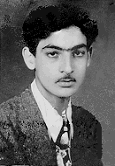 Born in Rajshahi (erstwhile East Pakistan) on 18th July 1935, Sarfaraz had three brothers and a sister. He started his education at St Anthony’s High School in Lahore, where his father worked with an Insurance Company. Sarfaraz matriculated from Government High School, Multan in 1948 at a remarkably early age of thirteen. A year earlier, he had been selected as a King’s Scout to attend a jamboree in UK and France. In Paris, we are told, his fervour for the impending birth of Pakistan knew no bounds. He hastily had his version of the Pakistan flag stitched by the Girl Guides (white bar consigned to the bottom, crescent in one corner, star in the other)! On the eve of Independence, Sarfaraz formed a troop of three Muslim scouts, proudly flaunting the new
fla
Born in Rajshahi (erstwhile East Pakistan) on 18th July 1935, Sarfaraz had three brothers and a sister. He started his education at St Anthony’s High School in Lahore, where his father worked with an Insurance Company. Sarfaraz matriculated from Government High School, Multan in 1948 at a remarkably early age of thirteen. A year earlier, he had been selected as a King’s Scout to attend a jamboree in UK and France. In Paris, we are told, his fervour for the impending birth of Pakistan knew no bounds. He hastily had his version of the Pakistan flag stitched by the Girl Guides (white bar consigned to the bottom, crescent in one corner, star in the other)! On the eve of Independence, Sarfaraz formed a troop of three Muslim scouts, proudly flaunting the new
fla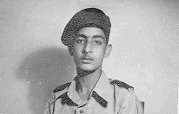 Sarfaraz was selected for the RPAF, though the Services Selection Board report was not very generous about his prospects of making a pilot. He joined the Joint Services Pre-Cadet Training School at Quetta. The Commandant of the School was impressed with Sarfaraz’s command of English, his confidence and his travels abroad at such an early
ag
Sarfaraz was selected for the RPAF, though the Services Selection Board report was not very generous about his prospects of making a pilot. He joined the Joint Services Pre-Cadet Training School at Quetta. The Commandant of the School was impressed with Sarfaraz’s command of English, his confidence and his travels abroad at such an early
ag Flying came easily to Sarfaraz, an ability that led him to exhibit careless tendencies and some over-confidence, as some of his instructors noted. He once pranged a Fury in Miranshah, breaking one of its landing gear; only a belly-landing at the better-endowed airfield of Peshawar saved the day. To sober him up, he was promptly administered a reprimand. Born fliers are known to follow the line of least resistance, but luckily for Sarfaraz, guidance was always at hand. He continued with a string of above average reports in his Advanced Flying Course as well as the Fighter Weapons Instructors' Course, both done in USA. He again showed his prowess as a superb fighter pilot by topping the course at PAF’s Fighter Leaders’ School in 1960. After yet another course at RAF's prestigious Fighter Combat School, he ended up piling a unique assortment of highly rated qualifications that served him (and the PAF) in good stead. As an exchange pilot in UK, he flew Hunters for two years. Sarfaraz's Officer Commanding in No 19 Squadron (RAF), reporting on his flying abilities, eloquently wrote, “In the air his experience and skill combine to make him a very effective fighter pilot and leader who creates an impression of disciplined efficiency in all that he
doe
Flying came easily to Sarfaraz, an ability that led him to exhibit careless tendencies and some over-confidence, as some of his instructors noted. He once pranged a Fury in Miranshah, breaking one of its landing gear; only a belly-landing at the better-endowed airfield of Peshawar saved the day. To sober him up, he was promptly administered a reprimand. Born fliers are known to follow the line of least resistance, but luckily for Sarfaraz, guidance was always at hand. He continued with a string of above average reports in his Advanced Flying Course as well as the Fighter Weapons Instructors' Course, both done in USA. He again showed his prowess as a superb fighter pilot by topping the course at PAF’s Fighter Leaders’ School in 1960. After yet another course at RAF's prestigious Fighter Combat School, he ended up piling a unique assortment of highly rated qualifications that served him (and the PAF) in good stead. As an exchange pilot in UK, he flew Hunters for two years. Sarfaraz's Officer Commanding in No 19 Squadron (RAF), reporting on his flying abilities, eloquently wrote, “In the air his experience and skill combine to make him a very effective fighter pilot and leader who creates an impression of disciplined efficiency in all that he
doe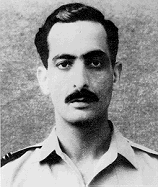 Sarfaraz’s sense of humour, seldom evident from his sole published photograph, was a very genial trait, amply noted at home and across the shores. As an officer, he was found to be courteous and well mannered with a pleasant personality. He was extremely popular and, socially well accepted. Swimming took up his leisure time, though his keenness for flying determined the daily routine.
Sarfaraz’s sense of humour, seldom evident from his sole published photograph, was a very genial trait, amply noted at home and across the shores. As an officer, he was found to be courteous and well mannered with a pleasant personality. He was extremely popular and, socially well accepted. Swimming took up his leisure time, though his keenness for flying determined the daily routine.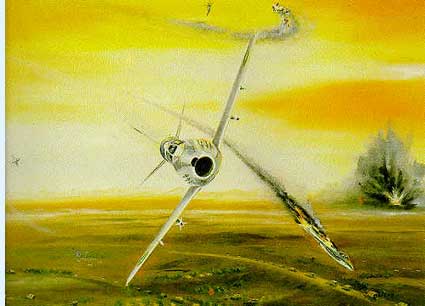 Then, with a quick-witted defensive
Then, with a quick-witted defensive 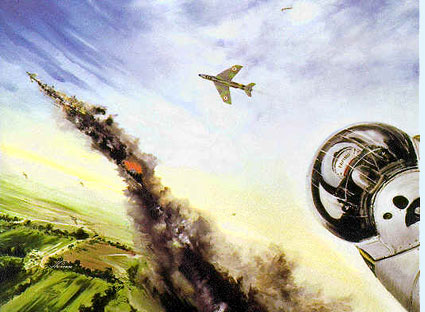 That evening, two pairs of Hunter CAPs (Combat
Air Patrols) were airborne, one from No 7 Squadron with Flg Off P S Pingale and
Flg Off A R Ghandhi and the other from No 27 Squadron with Flt Lt D N Rathore
and Flg Off V K Neb. Pingale and Ghandhi were in a left-hand orbit over the
airfield when Rafiqui broke off his attack and closed in on the nearest aircraft
(Pingale). Rafiqui’s guns, as usual, found their mark. Pingale, not sure what
hit him, lost control of his Hunter and ejected. Next, Rafiqui deftly manoeuvred
behind Ghandhi and fired at him, registering some hits. Just then, Cecil heard
his Squadron Commander call over the radio, “Cecil, my guns have stopped
firing, you have the lead.” Cecil promptly moved in to lead, with Rafiqui
sliding back as
That evening, two pairs of Hunter CAPs (Combat
Air Patrols) were airborne, one from No 7 Squadron with Flg Off P S Pingale and
Flg Off A R Ghandhi and the other from No 27 Squadron with Flt Lt D N Rathore
and Flg Off V K Neb. Pingale and Ghandhi were in a left-hand orbit over the
airfield when Rafiqui broke off his attack and closed in on the nearest aircraft
(Pingale). Rafiqui’s guns, as usual, found their mark. Pingale, not sure what
hit him, lost control of his Hunter and ejected. Next, Rafiqui deftly manoeuvred
behind Ghandhi and fired at him, registering some hits. Just then, Cecil heard
his Squadron Commander call over the radio, “Cecil, my guns have stopped
firing, you have the lead.” Cecil promptly moved in to lead, with Rafiqui
sliding back as